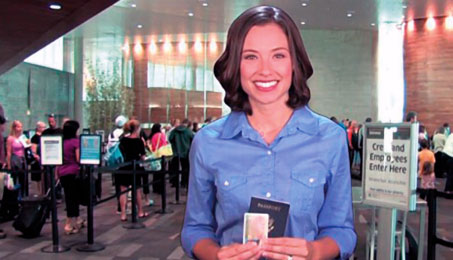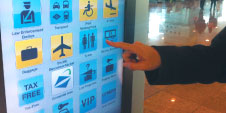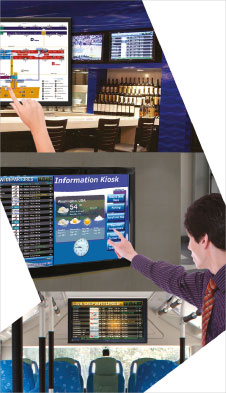
JFK, LaGuardia and Newark Liberty airports are among numerous to have installed virtual assistants.
Interactive kiosks, virtual assistants and video walls are all becoming a more common feature of the modern day airport. Ranging from the check-in process, to security checkpoints, to the arrivals area, new technology is having a telling impact on each stage of the journey through the airport.
As passenger demands and needs evolve, airports are adapting and one of the latest developments is the replacement of passenger-to-agent communication with technology-based alternatives.
One such example can be found in the rise of interactive kiosks, which can be used to find answers to common questions, get directions to a point of interest within the airport, or even have a face-to-face conversation with an agent via videoconference.
“Our solution has been designed with one thing in mind – the passengers,” said Matthew Horsman, International Strategy & Business Development, AERTEC Solutions, which has provided its touchscreen information kiosks to the likes of Barcelona, Madrid, Seville and Bilbao airports.
“It provides passengers with completely personalised information, leaving out any general information that would not be of interest to them. All this is done completely independently with the information being provided in real-time. If the passenger needs to, they can always contact a customer services team member via the simple videocall facility.”
Spanish airline Iberia is among those to have adopted AERTEC Solutions’ technology and has installed interactive Quick Service Points across its Madrid-Barajas T4 hub. “The passenger wants to feel independent and assisted at the same time. We serve many passengers with many different profiles and we have to meet the expectations of all of them,” said Alejandro Rivera Gil, Airport Development Project Manager, Iberia.
Passengers who have passed through Munich Airport may also be familiar with a solution known as the InfoGate. Developed by FMG, the airport’s operator, with the screen technology supplied by NEC Display Solutions, passengers can use the InfoGate to connect to an information service representative via videoconference. In addition, they can also be used to obtain information on airport services, shopping and dining options at Munich Airport.
Virtual assistants
Another alternative to the human agent that has recently emerged is the virtual assistant – a virtual airport agent that is created by projecting an image onto a human-shaped board. The virtual assistant is now a widespread feature in airports and can be found around the world, ranging from London Luton and JFK International Airport, to Boston Logan and Frankfurt.
The virtual assistant at Frankfurt Airport has been installed in Condor’s check-in area. Christian Schmitt, the airline’s Vice President Ground Operations, said: “We’re always looking for ways to make our customers’ journeys as easy and relaxing as possible and the virtual assistant enables us to provide them with valuable information that can speed up the check-in process.”
The Airport Virtual Assistants that have been installed at JFK, LaGuardia and Newark Liberty airports have been supplied by airportONE.com and L. Patrick Bienvenu, the company’s Principal, explained that they are especially effective at the entrance to the security search area.
“With larger airports, the most important advantage relates to security pre-screening,” he said. “As we all know, security lines are getting longer and longer. We have found that Airport Virtual Assistants are extremely effective in capturing attention. Passengers seem to be amazed by the technology and it appears that they most definitely listen to the message being delivered.”
He continued: “Why is this so important for security pre-screening? It’s because you now have a very effective tool to get passengers ready for security screening, prior to the point of reaching the inspection chokepoint.”

A number of airports have recently installed interactive kiosks, such as the one pictured at Barcelona Airport, which was provided by AERTEC Solutions.
‘Wow factor’
Some airports have gone the extra mile to provide an innovative solution that can define the entire airport experience. Among them is Vienna International Airport, which has installed a video wall in the security area in Check-in 3, which is made up of 100 screens supplied by NEC Display Solutions. As passengers approach the security zone, a series of letters cascade down the wall to create the topography of a landscape.
Richard Wilks, Aviation Business Development Manager at NEC Display Solutions, said: “Everyone is focusing on the passenger experience and this is a really innovative and subtle way of improving the passengers’ experience.
“Everybody is looking for that ‘wow factor’ in an airport and the video wall at Vienna really delivers that.”
The concept of the video wall is not unique to Vienna Airport and Wilks explained that similar innovations can also be found at Munich Airport’s Terminal 2 and six airports across Norway, among other destinations.
While each of these solutions – interactive kiosks, virtual assistants and large-scale video walls – all serve a different purpose, what they do have in common is the fact that they all contribute to an improved airport experience. They may only be in place at select locations at present, but the positive passenger reaction should ensure that they become a more common sight in the coming months and years.

microFIDS provide new ways to help passengers
microFIDS is a wireless, compact FIDS screen that can be deployed anywhere – on standard displays, touch-screens, small tablets and in airport shuttle buses. With recent enhancements, customers are using microFIDS to develop innovative applications throughout the airport.
“As we built more capabilities into microFIDS, customers began tailoring systems to their own needs,” said Christopher Forrest, Managing Director at ARINC Managed Services. “Airports are using the system’s flexibility to create passenger-centric applications.”
Some of its most successful implementations have been in airport concession areas, where its size and features make it easy to deploy wherever it can be easily seen. Customers keep tabs on their flights while they eat, or enjoy an extra dessert if their flight is delayed.
In other instances, airports are using microFIDS as full-service information kiosks. The kiosks can integrate wayfinding, terminal maps, parking and concession updates; weather, news and special announcements; and of course arrival and departure information – all in one display. With 2D bar code scanning, passengers can scan a phone or boarding pass for instant display of specific flights.
Mobile deployment on shuttle buses has been another compelling application. The system can automatically display flight information on the way to the airport for drop-off and then switch to customised local area content or paid advertising on the return.
Forrest added: “Our customers love that microFIDS is simple to deploy and affordable – plug and play and pay by subscription. They also love the customisation opportunities. Some are using this to generate revenue through paid advertising and others are enhancing customer service. By tying in wayfinding and other traveller services, airports are converting their microFIDS into cost effective information kiosks and more.”







